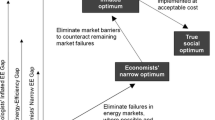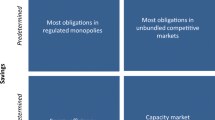Abstract
Both Top Runner in Japan and Ecodesign in the European Union are schemes to set requirements on the energy efficiency (minimum efficiency performance standards, MEPS) of a variety of products. This article provides an overview of the main characteristics and results of both schemes and gives recommendations for improving them. Both schemes contribute significantly to the energy efficiency targets set by the European Commission and the Japanese government. Although it is difficult to compare the absolute levels of the requirements, comparison of the relative improvements and of the savings on household electricity consumption (11 % in Japan, 16 % in the EU) suggest they are in the same range. Furthermore, the time needed to set or review requirements is in both schemes considerable (between 5 and 6 years on average) and the manageability increasingly will become a challenge. The appeal of the Top Runner approach is that the most efficient product (Top Runner) sets the standard for all products at the next target year. Although the Ecodesign scheme includes the elements for a Top Runner approach, it could exploit this principle more explicitly. On the other hand, the Top Runner scheme could benefit by using a real minimum efficiency performance standard instead of a fleet average. This would make the monitoring and enforcement more simple and transparent, and would open the scheme for products where the market situation is less clear.

Similar content being viewed by others
Notes
If not at the first analysis then certainly for the second and following analysis; otherwise, monitoring and enforcement would not be possible.
Except for transformers due to a market shift to larger transformers which have larger absolute losses.
This Directive is the recast of the original Ecodesign Directive from 2005. The main difference is that the scope of the Directive is extended from energy using products to energy related products.
An energy related product is a product that has an impact on energy consumption during use (Article 2(1)), including both products that comsume energy during use themselves (e.g. a refrigerator, a television or an electric motor) and products that impact the energy consumption during use of other products (e.g. a window or a shower head).
Although the scope of the Directive has been extended to energy related products no implementing measures for such products are being prepared yet.
Stakeholders are industry representatives, NGOs and EU member state experts.
Because the measurements were carried out in shops, it was not known when the products measured were placed on the market and therefore it could not be established with certainty whether the products measured should have been compliant with the requirements. Products placed on the market before the requirements went into force can be legally sold after the entry into force date.
Total primary energy consumption in 2020 is estimated at 1968 Mtoe (European Commission 2011a, p. 21), equivalent to 22 888 TWh. Final consumption (all electricity) of products covered by Ecodesign measures converted to primary energy with factor 2.5 results in 6790 TWh.
The 20 % energy efficiency target (in primary energy) results in 368 Mtoe (European Commission 2011a, p. 21), equivalent to 4,273 TWh. Savings (all electricity) in 2020 of products covered by Ecodesign converted to primary energy with factor 2.5 result in 965 TWh.
The IEA 4E (efficient electrical end-use equipment) implementing agreement has an Annex (Mapping and Benchmarking) to undertake such international comparisons.
And some Member States, e.g. Spain and Germany, have delegated the enforcement to lower levels in their hierarchy so that they have multiple enforcement authorities.
References
Almeida, A. de, Patrão, C., Rivière, P., da Silva, D., Schlomann, B., Harrison, B. (2011). Standby and off-mode power demand of new appliances in the market. EEDAL 2011 conference proceedings. Can be downloaded from http://re.jrc.ec.europa.eu/energyefficiency/EEDAL/index.htm.
Bertoldi, P., & Atanasiu, B. (2009). Electricity consumption and efficiency trends in European union—status report 2009. Luxembourg: Publications Office of the European Union.
Capros, P., Mantzos, L., Papandreou, V., & Tasios, N. (2008). European energy and transport—trends to 2030, update 2007. Luxembourg: Office for Official Publications of the European Communities.
CSES (2011). Evaluation of the Ecodesign Directive (2009/125/EC)—first findings report. Can be downloaded from http://www.cses.co.uk/upl/File/CSES-eco-design-evaluation-first-progress-report-Revised-version-05-05.pdf.
Directive 2005/32/EC of the European Parliament and of the Council of 6 July 2005 establishing a framework for the setting of ecodesign requirements for energy-using products and amending Council Directive 92/42/EEC and Directives 96/57/EC and 2000/55/EC of the European Parliament and of the Council. OJ L191, p. 29–58, 22.07.2005.
Directive 2009/125/EC of the European Parliament and of the Council of 21 October 2009 establishing a framework for the setting of ecodesign requirements for energy-related products (recast). OJ L285, p. 10–35, 31.10.2009.
Directive 2010/30/EU of the European Parliament and of the Council of 19 May 2010 on the indication by labelling and standard product information of the consumption of energy and other resources by energy-related products (recast). OJ L153, p. 1–12, 18.06.2010.
European Parliament (2011). Report A7-0219/2011. Can be downloaded from http://www.europarl.europa.eu/sides/getDoc.do?type=REPORT&reference=A7-2011-0219&language=EN.
European Commission (2011a). Energy Efficiency Plan 2011; Impact Assessment. SEC(2011) 277 final. Brussels.
European Commission (2011b). Energy Efficiency Plan 2011. COM(2011) 109/4. Brussels.
Geller, H., Harrington, P., Rosenfeld, A. H., Tanishima, S., & Unander, F. (2006). Polices for increasing energy efficiency: thirty years of experience in OECD countries. Energy Policy, 34, 556–573.
Jepsen, D., Spengler, L., Reintjes, N., Rubik, F., Schomerus, T. (2011). Product-related top runner approach at EU level. Federal Environment Agency (Umweltbundesamt), Dessau-Rosslau. Can be downloaded from http://www.uba.de/uba-info-medien/4122.html.
Kemna, R., van Elburg, M., Li, W., & van Holsteijn, R. (2005). MEEUP methodology report. Delft: Van Holsteijn en Kemna for European Commission.
Kemna, R., van Elburg, M., Li, W., & van Holsteijn, R. (2007a). Eco-design of CH-Boilers. Delft: Van Holsteijn en Kemna.
Kemna, R., van Elburg, M., Li, W., & van Holsteijn, R. (2007b). Eco-design of water heaters. Delft: Van Holsteijn en Kemna.
Kimura, O. (2010). Japanese Top Runner Approach for energy efficiency standards. SERC Discussion Paper, CRIEPI. Can be downloaded from: http://criepi.denken.or.jp/jp/serc/discussion/index.html.
METI (2009). Household electricity consumption by equipment in 2009 (in Japanese), downloaded at 28 October 2011 from http://www.meti.go.jp/committee/summary/0004310/016_05_02.pdf.
METI (2010). Top Runner Program—developing the world’s best energy-efficient appliances, March 2010. Can be downloaded from http://www.asiaeec-col.eccj.or.jp/top_runner/index.html.
Murakoshi, C. et al. (1999). Revision of Japanese Appliance Energy Efficiency Standards, ECEEE 1999 Summer Study Proceedings, Panel 1.10.
Murakoshi, C. et al. (2005). New challenges of Japanese energy efficiency program by Top Runner approach, ECEEE 2005 Summer Study Proceedings, 767–777.
Nordqvist, J. (2006). Evaluation of Japan’s Top Runner programme, AID-EE project. Can be downloaded from: http://www.aid-ee.org/documents/018TopRunner-Japan.PDF.
Siderius, H-P. (2004). The End of Energy Efficiency Improvements = The Start of Energy Savings?!, ACEEE 2004 Summer Study on Energy Efficiency in Buildings, 11-165–11-176.
Spengler, L., & Jepsen, D. (2010). Auswirkungen und Potenzial der Durchführungsmassnahmen der Ökodesign-Richtlinie. Hamburg: Ökopol GmbH.
Tojo, N. (2005). The Top Runner Program in Japan—its effectiveness and implications for the EU, Naturvardsverket, Report 5515, Stockholm.
Turiel, I., Chan, T., & McMahon, J. E. (1997). Theory and methodology of appliance standards. Energy and Buildings, 26, 35–44.
Author information
Authors and Affiliations
Corresponding author
Annex
Annex
Rights and permissions
About this article
Cite this article
Siderius, P.J.S., Nakagami, H. A MEPS is a MEPS is a MEPS: comparing Ecodesign and Top Runner schemes for setting product efficiency standards. Energy Efficiency 6, 1–19 (2013). https://doi.org/10.1007/s12053-012-9166-6
Received:
Accepted:
Published:
Issue Date:
DOI: https://doi.org/10.1007/s12053-012-9166-6




